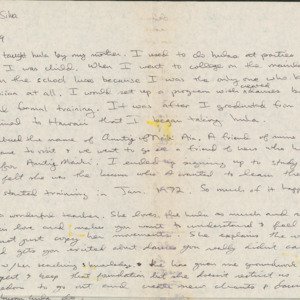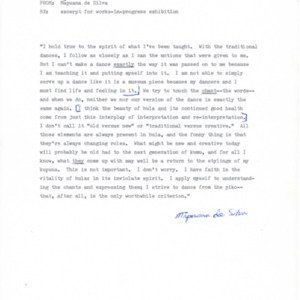Māpuana deSilva
Title
Māpuana deSilva
Description
Māpuana deSilva
Māpuana deSilva established Hālau Mōhala ‘Ilima in 1976 which is currently situated in Kailua, O‘ahu.
I am learning to hold true to the spirit of what my teacher gave me. I think now that this spirit comes in two parts. First, it is my duty to respect and preserve the traditional dances. If I inherit a holokū from my grandmother I don’t chop it into a mini-skirt just because fashions have changed. The same is true for the chants and hula that have been given to me. They are priceless gifts; I shouldn’t be so presumptuous as to fiddle with them just to keep up with what is fashionable. Secondly, it is also my duty to create. I am a keeper of the record of my own time and of my own place. With my husband Kihei, I create mele hula for my family, my dancers and my Kailua home. We have tried to re-create the chant and dance tradition of Kailua which for several generations has largely been hidden in books and Hawaiian language newspapers. Did you know that Kawainui Marsh was once a fishpond and before that a lagoon? Did you know that Hawaiians have lived on its banks for 1500 years and that Kailua was once immeasurably wealthy and an ancient center for the arts? It’s my duty and pleasure to revive the chants which speak of those things, and to create new mele that remind us of what was, describe what is, and ask of what will be. So you see I’m learning that I have two roles. I’ve tried to keep and honor what was passed on to me, and I’ve worked hard to build through creation and recreation, a tradition of my own.
It was after I graduated from college and returned to Hawai‘i that I began taking hula in a serious way. I had been taught hula ‘auwana by my mother as I was growing up but in 1972 I was introduced to Aunty Mā‘iki Aiu Lake and I immediately felt that she was the kumu I wanted to learn the hula from in a deeper way. I started my training that January and I found Aunty Mā‘iki to be a wonderful teacher. She loves the hula so much and she conveys this love to her students. Aunty Mā‘iki made us want to feel and understand the dance and not just copy her movements. She explained the words and stories of the mele and she got me excited about dances that I didn’t really care for. Aunty Mā‘iki was very generous with her knowledge but she didn’t restrict us. She gave me my foundation in the hula, a foundation that I keep and respect, but she gave us the freedom to go out and create new chants and dances.
My ‘ūniki in 1975 was very special because Aunty made the graduation process so demanding. We were disciplined and tested because she wanted us to have strong values and beliefs in the hula and in our lives. She wanted us to find out for ourselves if we really wanted to accept the responsibility of becoming kumu hula. Through the encouragement of my mother and family, I began to teach in Kailua in 1976. I wanted people to understand our culture in the same way that it was presented to me by Aunty Mā‘iki. Hula is one of the few things that you can study in the Hawaiian culture that teaches you every other aspect of Hawaiian life. There is a spiritual strength in hula that I wanted other people to experience because it can in turn strengthen their own lives.
There are certain dances like “Kaulilua”, “A Ko‘olau Au”, and “Au‘aia” that are not for everybody. I hold them back because I think of them as ‘ūniki dances. They are the oldest dances that have been shared with me and they have been passed down from generation to generation. These dances are the foundation of my hālau and my training and I will never change the way I was taught them. To create in hula you have to do your homework and open your heart. I think that there are boundaries to creativity and they are based on common sense. If you’re going to create a traditional hula you shouldn’t wind up with a square dance. You have to know your text, you have to feel the magic of the language and you have to be well-versed in hula’s traditional vocabulary of motions. Only then can you conscientiously experiment and innovate. Only then can you explore the art without violating it.
Māpuana deSilva established Hālau Mōhala ‘Ilima in 1976 which is currently situated in Kailua, O‘ahu.
I am learning to hold true to the spirit of what my teacher gave me. I think now that this spirit comes in two parts. First, it is my duty to respect and preserve the traditional dances. If I inherit a holokū from my grandmother I don’t chop it into a mini-skirt just because fashions have changed. The same is true for the chants and hula that have been given to me. They are priceless gifts; I shouldn’t be so presumptuous as to fiddle with them just to keep up with what is fashionable. Secondly, it is also my duty to create. I am a keeper of the record of my own time and of my own place. With my husband Kihei, I create mele hula for my family, my dancers and my Kailua home. We have tried to re-create the chant and dance tradition of Kailua which for several generations has largely been hidden in books and Hawaiian language newspapers. Did you know that Kawainui Marsh was once a fishpond and before that a lagoon? Did you know that Hawaiians have lived on its banks for 1500 years and that Kailua was once immeasurably wealthy and an ancient center for the arts? It’s my duty and pleasure to revive the chants which speak of those things, and to create new mele that remind us of what was, describe what is, and ask of what will be. So you see I’m learning that I have two roles. I’ve tried to keep and honor what was passed on to me, and I’ve worked hard to build through creation and recreation, a tradition of my own.
It was after I graduated from college and returned to Hawai‘i that I began taking hula in a serious way. I had been taught hula ‘auwana by my mother as I was growing up but in 1972 I was introduced to Aunty Mā‘iki Aiu Lake and I immediately felt that she was the kumu I wanted to learn the hula from in a deeper way. I started my training that January and I found Aunty Mā‘iki to be a wonderful teacher. She loves the hula so much and she conveys this love to her students. Aunty Mā‘iki made us want to feel and understand the dance and not just copy her movements. She explained the words and stories of the mele and she got me excited about dances that I didn’t really care for. Aunty Mā‘iki was very generous with her knowledge but she didn’t restrict us. She gave me my foundation in the hula, a foundation that I keep and respect, but she gave us the freedom to go out and create new chants and dances.
My ‘ūniki in 1975 was very special because Aunty made the graduation process so demanding. We were disciplined and tested because she wanted us to have strong values and beliefs in the hula and in our lives. She wanted us to find out for ourselves if we really wanted to accept the responsibility of becoming kumu hula. Through the encouragement of my mother and family, I began to teach in Kailua in 1976. I wanted people to understand our culture in the same way that it was presented to me by Aunty Mā‘iki. Hula is one of the few things that you can study in the Hawaiian culture that teaches you every other aspect of Hawaiian life. There is a spiritual strength in hula that I wanted other people to experience because it can in turn strengthen their own lives.
There are certain dances like “Kaulilua”, “A Ko‘olau Au”, and “Au‘aia” that are not for everybody. I hold them back because I think of them as ‘ūniki dances. They are the oldest dances that have been shared with me and they have been passed down from generation to generation. These dances are the foundation of my hālau and my training and I will never change the way I was taught them. To create in hula you have to do your homework and open your heart. I think that there are boundaries to creativity and they are based on common sense. If you’re going to create a traditional hula you shouldn’t wind up with a square dance. You have to know your text, you have to feel the magic of the language and you have to be well-versed in hula’s traditional vocabulary of motions. Only then can you conscientiously experiment and innovate. Only then can you explore the art without violating it.
Citation
“Māpuana deSilva,” Nā Kumu Hula Archive, accessed August 25, 2025, https://nakumuhula.org/archive/items/show/43.



